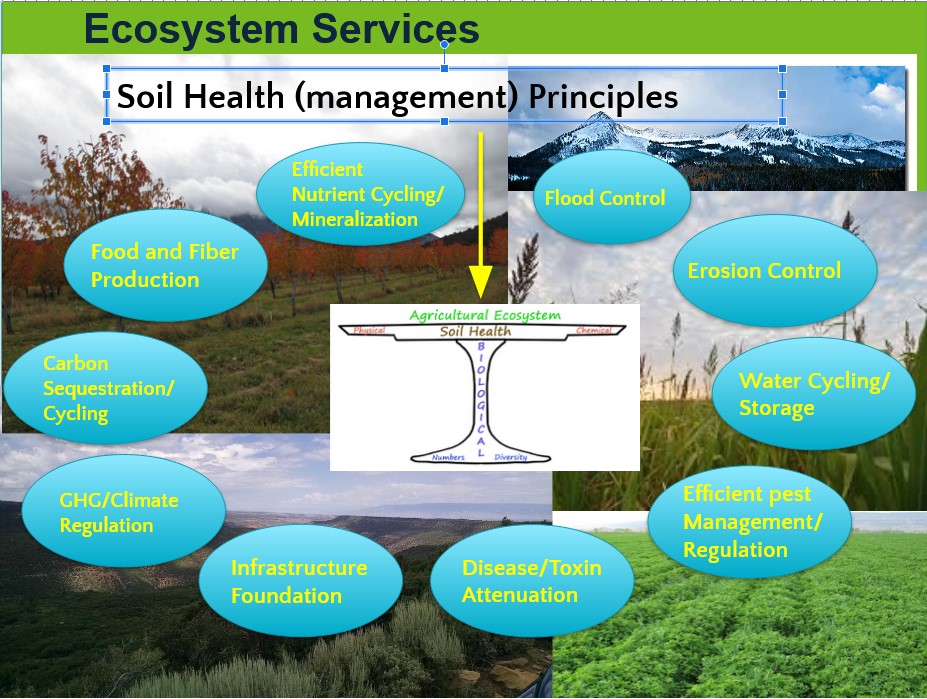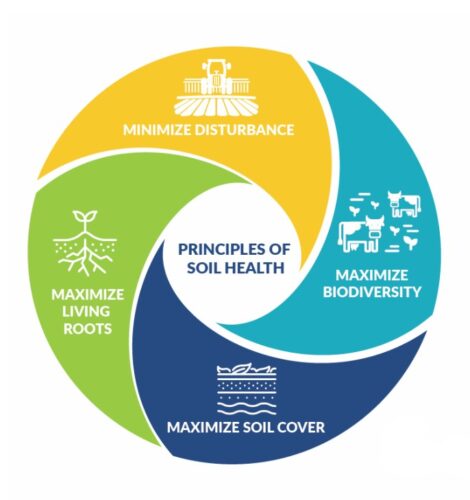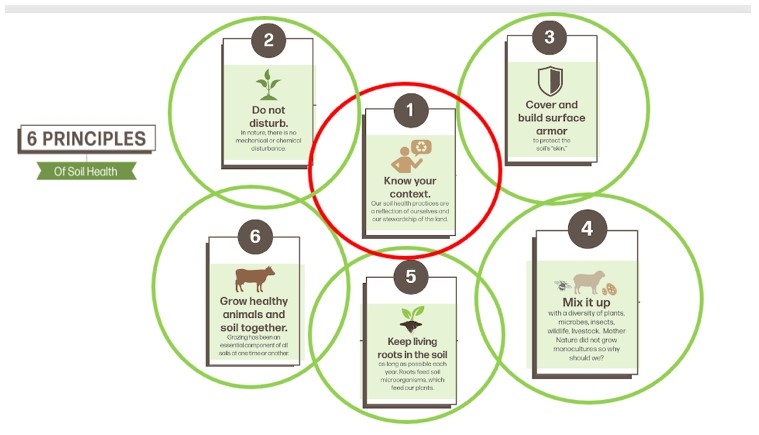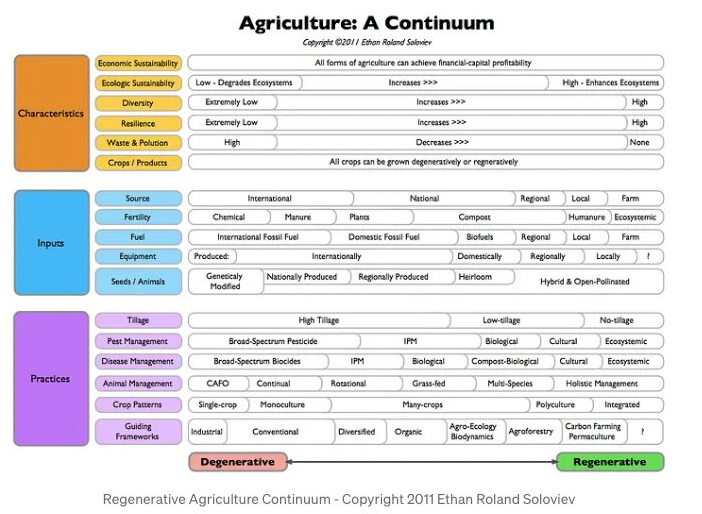Cattle grazing multispecies cover crop after corn. Near Loma, Colorado
There are many websites, texts, and articles that delve deep into the concepts of soil health. This page is meant to be a brief and succinct introduction, not an exhaustive explanation.
Soil Health: It Really Is All About Biology!
A healthy soil supports plant growth, maintains a stable ecological balance (chemically, physically, and biologically), and contributes to various ecosystem functions or services.
NRCS definition for “soil health”: The capacity of soil to function as a vital living ecosystem that sustains plants, animals, and humans. (emphasis mine)
Key components of soil health include:
- Physical Properties: These relate to the soil’s structure, texture, and porosity. A healthy soil has strong structure, specifically at the soil surface, allowing for adequate water infiltration, root penetration, and air circulation. It also resists erosion and compaction.
- Chemical Properties: Soil pH, Electrical Conductivity (a salinity measurement), organic matter (energy and structure), and plant nutrient availability, are crucial chemical aspects. A near neutral pH lends to sufficient availability of essential nutrients to support plant growth. All soil chemistry is mediated by the different pools of organic material and more specifically by…
- Biological Activity: Soil health essentially pivots on the diversity and activity of microorganisms, such as bacteria, fungi, and an innumerable host of other organisms in the soil food web. This food web is a critical player in all of the global ecosystem processes: nutrient (mineral) cycling, energy or carbon cycling (organic matter and carbon pools) and, water cycling, both global (ocean driven) and small (landscape driven). The biological component of soil modifies every other soil property, both chemical and physical. Even those properties that aren’t necessarily considered “dynamic” or changing, such as texture. Soil depth may be the only property that biology does not effect… and even that’s arguable.
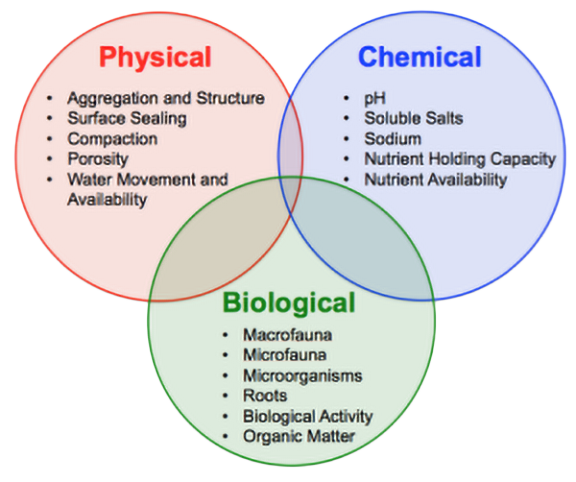
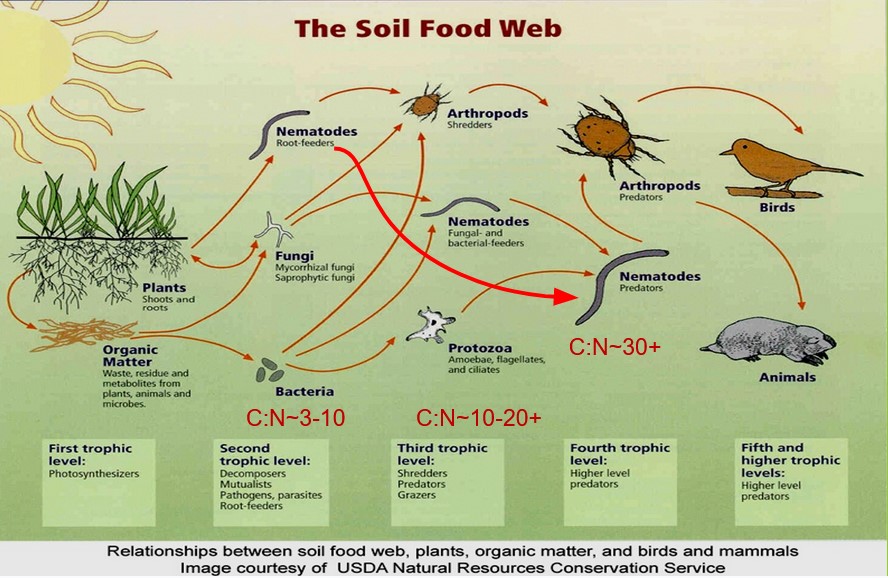
Managing for Soil Health
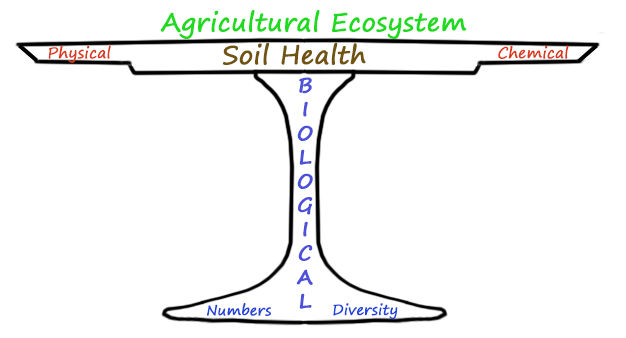
In the image above the agricultural ecosystem is balanced solidly on a pedestal table where the main supporting pillar is biologically focused management
. Specifically, we manage for diversity and numbers of all members of the soil food web. Managing for soil biology will strengthen and build the central support for the agro-ecosystem making it more resilient to natural and human
induced assaults.
Synthetic chemical management practices are used judiciously, if at all. Natural nutrient or mineral amendments are only used to tweak the system based on how we think it works, not to bludgeon it into our notion of what we think it should be. Being to heavy handed with either synthetics or natural amendments can add minor to severe imbalance to the system.
Physical treatments are largely modifying or removing tillage or cultivation practices that destroy soil structure and introduce an unnatural load of oxygen into the soil ecosystem. If tillage is re-introduced into a no-till system it will add a heavy, although temporary, imbalance to the agroecosystem. For rangeland, grazing management to minimize bare ground and compaction will positively affect the ecosystem stability.
Keyline subsoiling, a physical treatment to break up compaction, can immediately increase infiltration. This may be appropriate in some cases. Plowing to control weeds? Maybe when first transitioning your system, but understand what
it is that you are doing and take steps to mitigate the damage. By the way, one of the first critters to leave when you till… predatory nematodes! Yeah, we want those to stick around – see what they eat in the Soil Food Web image
above.
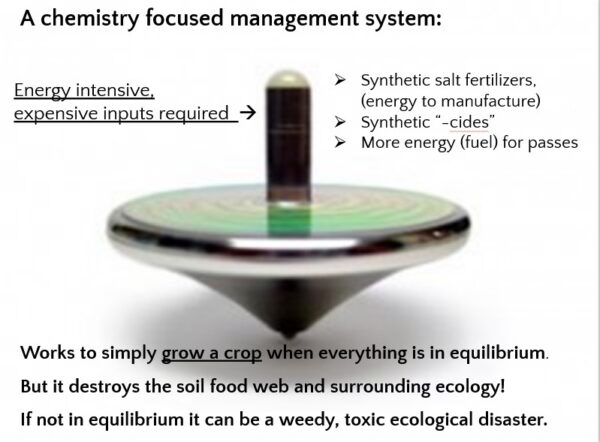
In contrast, this image depicts the management paradigm we’ve been using for almost 100 years, specifically on cropland. But there are strong parallels to rangeland. Management by synthetic chemistry and heavy handed mechanical manipulation.
Both approaches are expensive and ecologically unsound. This is not setting up your farm or ranch for resiliency, it’s setting it up for a crash.
Note to the followers of Albrecht – I know some of you may get your knickers in a knot over the focus on biology. I do understand the approach to balancing soils with chemistry – mainly through “natural” amendments such as lime, gypsum, rock dusts, etc. I don’t have a problem with this until someone says to add tons per acre of this or that. That’s a big red flag. Too much of anything is a bad idea (even compost). Pounds per acre is more appropriate. A better approach – tweak the system with small amounts of mineral amendments, but only when a conventional soil test shows a severe imbalance (high Mg or Na, very low or high pH). If you’re starting with tight, dense soil because of high Na or Mg, by all means add some lime or gypsum (you’ll have to break it up first though), make the chemistry tweaks, then let the biology do the work. Always add a humic or fulvic acid with any amendment – it’s food for the biology. William Albrecht was a brilliant chemist – and that was his approach, chemistry. Personally I would rather approach soil health from an ecological position. Obviously there are nuances to consider.
I would highly, HIGHLY, recommend this webinar by John Kempf at AEA. He articulately explains why biology trumps chemistry. Long QA but it’s also informative.
The Primary Goal Of Managing For Soil Health:
Building biological diversity, activity, and Soil Organic Matter (SOM) via maximum photosynthesis.
SOM could be considered a kind of “universal buffer”. There are textbooks with many chapters devoted to SOM and it’s many attributes and functions. But in the following paragraphs I’ll briefly point out the primary soil properties that it affects.
Bulk Density – The density of soil decreases with increasing SOM. This indicates more pore space or porosity. Porosity positively influences what we call “available water holding capacity” or AWC. This means the soil holds more of the water it receives by precipitation or irrigation. Since more water is held in the soil profile, there is less nutrient and salt loss (called leaching) into our ground water, rivers, and lakes. Increased AWC buffers the soil (and crops) against drought! SOM itself, depending on its decomposition state and amount, can hold 10-1000 times more water than the mineral fraction of the soil. High porosity (low bulk density) also aids in gas exchange within the soil profile, essentially helping the biology and plant roots to breathe. This also provides an oxygenated sub-aqueous habitat ideal for microbial life.
Soil Structure – Also known as aggregation, the strength of soil increases with increasing SOM. This strength can be visually observed as the structure of the soil. Structure is also related to Bulk Density, stronger structures have lower bulk densities than their weaker counter parts. Strong soil structure helps to keep compaction to a minimum and thus keeps the porosity and AWC at higher levels and allows abundant root growth. It also buffers the soil from occasional abuses such as over grazing or heavy vehicle traffic. Structure can also be influenced by other soil properties such as calcium carbonate, iron oxides, and clay percentage (texture).
Friability – This term refers to how “soft” the surface soil is, or how easily it crumbles in your hands. Soft soil has good friability. This might seem contradictory to strong structure but in this case the “crumbles” are actually small, very strong aggregates that don’t collapse into muddy goo. Friable soils are easy to cultivate and are specifically easier to plant into with no-till drills and seeders and generally have better results with broadcast or aerial seeding.
Surface Infiltration – Increasing SOM increases porosity and strong structure. If the surface of the soil is minimally disturbed these properties, in turn, increase water infiltration from the surface down into the soil profile. Water that does not infiltrate into the soil profile is called runoff. If there is no slope water will pond in depressions. Obviously we want as much infiltration as we can get – capturing every bit of precipitation or irrigation. Decreasing runoff reduces evaporation, erosion and movement of sediment, fertilizer, pesticide, and herbicide into our river and lake systems. It is also a major factor in flood control and mitigation.
Nutrient cycling and CEC – Nutrient or mineral cycling is increased in at least two ways: 1) less leaching and runoff as explained above. 2) SOM itself can be a large source, or pool, of nutrients available for use by plants and soil biology. Nutrients in the form of SOM are especially beneficial because they are not susceptible to transport and they are “time released”. The releasing of nutrients from SOM is called mineralization and is mediated specifically by soil biology. Cation Exchange Capacity (CEC) is a soils ability to hold some of the major nutrients (cations) thus making them available to plants. SOM greatly increases CEC and can be the dominant source of CEC in sandy soils.
Toxin Retention – SOM may bind, or immobilize, heavy metal and organic contaminants in soils where they may be held for some time and/or biologically degraded over time. But this chemistry can be quite complex and in some instances SOM may increase metal solubility/mobility. That subject is too complicated to get into for our purposes here.
Maximize photosynthesis, soil food web activity, and SOM by following the principles of soil health management.
What is a principle? – It is a fundamental, primary, or universal law or truth. A concept to guide your decisions but in itself is not a specific action.
The images above and below display the core principles that guide management for soil health according to the organization that promotes them. You’ll find that most “principles” of soil health management are very similar. And
each principle applies essentially to supporting SOIL BIOLOGY. Notice the principles are FEW. NRCS promotes 4, Understanding Ag promotes 6. Personally I like UA’s breakdown best. Especially
with addition of context, which is a great segue into practices.
Knowing the difference between a principle and a practice is vitally important!
What is a practice? – It is the act or process of doing something; actions or activities. A method.
Principles are few, practices are innumerable. Principles are the over-arching ideas and concepts, practices are the detailed, nitty-gritty, actions that you take to work toward the principles.
Examples: General – “I’m implementing rotational grazing” OR, detailed – I’m implementing adaptive rotational grazing with 24 paddocks. 10 on irrigated pasture, 14 on native range. Also incorporating winter bale grazing on poorer condition
rangeland.”
The specific actions, or practices you apply depend entirely on … CONTEXT! See UA’s link above for a good explanation of context.
Understand the principles – they are universal, and they apply anywhere. Then plan your practices accordingly.
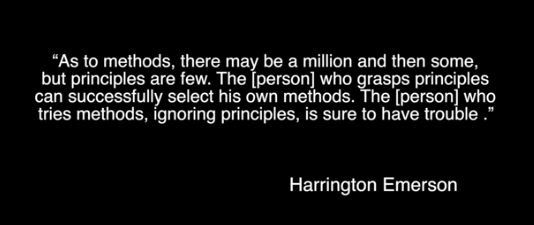
Regenerative Agriculture… what is it? Here’s my take:
Regenerative agriculture should have no specific definition, and in my opinion, should never be specifically defined by any institution.
The reason being that the term can be hijacked to mean something it maybe shouldn’t. Or it can be diluted to lose any meaning – similar to “sustainable”, or dare I say it “organic”.
So how should the term be conveyed or described then? There could be several ways to conceptualize Regenerative Ag – as a mindset, a journey, or even a world view. We could really get into the weeds from here but I’ll keep it fairly
superficial for the sake of brevity.
Instead of a definition, I like to look at Regenerative Ag as a continuum. Specifically, Ethan Soloviev’s version. He formulated the figure below depicting agriculture on a continuum from degenerative to regenerative. Every producer falls on this scale somewhere. There is no index, no certification, no binding rules that label a “gold standard”… whatever that may be. Find yourself on the scale and make a choice as to where you want to go from there.
Regarding a producer that would like to convey that they are regenerative, I think transparency is the simplest, most honest, way to reveal intent toward regeneration. People like honesty and transparency… really. If you’re still
using tillage and synthetics, state why. State your intent and the practices you use to move in a regenerative direction. State your current characteristics, then state the characteristics you hope to attain. This may be a bit a
simplistic or even naive. Maybe this would seem to make a producer too vulnerable to be this transparent. I don’t think so. Given how much the consumer has been deceived and manipulated I think they would welcome such honesty and
transparency. I’m a consumer, and I would LOVE to see this. Of course the consumer needs to be educated regarding the details of inputs, practices, and outcomes (characteristics). Those who want to know will learn.
I think the figure could be expanded upon greatly. Social aspects should have a place on the scale. I would like to see Characteristics listed as Outcomes. It’s a great start, though I have no idea how much traction it has if any because so many want a definition and a label.
But I do need to make a clear point – I do NOT think certifications are a bad thing nor participation in their process. There are many regenerative certifications coming on line who’s standards look fantastic and seem to flow towards
the regenerative side of the continuum. HOWEVER, (speaking to producers) don’t let the certification become your reason for doing what you’re doing. Don’t let any certification become dogmatic handcuffs. This can be hard to see from
the inside, so be aware.
More on Ecosystem Services coming soon.
